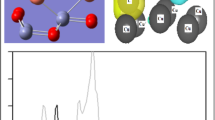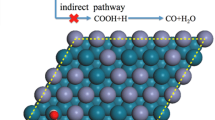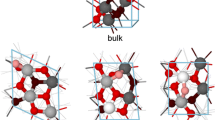Abstract
The polar ZnO surfaces have received wide interests due to their higher activity than the nonpolar facets in catalysis, photo-catalysis and gas sensitivity. However, the theoretical study on the relative stability of the polar ZnO surfaces is still limited. In this work, two different methods were used to calculate the surface energy of the polar ZnO(0001)–Zn and Zn(000-1)–O surfaces. The empirical pair potential method shows that the ZnO(000-1)–O terminal is more stable than the ZnO(0001)–Zn terminal because the polarizability of surface O2− is higher than that of surface Zn2+, which is in good agreement with the experimental results. However, the classic local energy density method predicts a higher stability of the ZnO(0001)–Zn terminal. The overestimation of the stability of the ZnO(0001)–Zn terminal originates from more distribution of the transferred charge to the ZnO(0001)–Zn terminal as the electron acceptor. We propose a hybrid method to fairly redistribute the contribution of the transferred charge to electron donor and electron acceptor and make the same stability trend with the experimental studies.





Similar content being viewed by others
References
Strunk J, Kahler K, Xia XY, Muhler M (2009) Surf Sci 603(10–12):1776–1783
Sadjadi S, Eskandari M (2012) Monatsh Chem 143(4):653–656
Mclaren A, Valdes-Solis T, Li GQ, Tsang SC (2009) J Am Chem Soc 131(35):12540
Nassehinia HR, Gholami M, Jafari AJ, Esrafily A (2013) Asian J Chem 25(6):3427–3430
Driessen MD, Miller TM, Grassian VH (1998) J Mol Catal A Chem 131(1–3):149–156
Kim J, Yong K (2011) J Phys Chem C 115(15):7218–7224
Li GR, Hu T, Pan GL, Yan TY, Gao XP, Zhu HY (2008) J Phys Chem C 112(31):11859–11864
Han XG, He HZ, Kuang Q, Zhou X, Zhang XH, Xu T, Xie ZX, Zheng LS (2009) J Phys Chem C 113(2):584–589
Noguera C, Goniakowski J (2013) Chem Rev 113(6):4073–4105
Leonard RB, Searcy AW (1971) J Appl Phys 42(10):4047
Kohl D, Henzler M, Heiland G (1974) Surf Sci 41(2):403–411
Na SH, Park CH (2009) J Korean Phys Soc 54(2):867–872
Liu PL, Siao YJ (2011) Scr Mater 64(6):483–485
Wander A, Schedin F, Steadman P, Norris A, McGrath R, Turner TS, Thornton G, Harrison NM (2001) Phys Rev Lett 86(17):3811–3814
Chetty N, Martin RM (1992) Phys Rev B 45(11):6074–6088
Jacquemin D, Le Bahers T, Adamo C, Ciofini I (2012) PCCP 14(16):5383–5388
Yu M, Trinkle DR, Martin RM (2011) Phys Rev B 83(11):115113
Sun XW, Chu YD, Song T, Liu ZJ, Zhang L, Wang XG, Liu YX, Chen QF (2007) Solid State Commun 142(1–2):15–19
Lewis GV, Catlow CRA (1985) J Phys C Solid State 18(6):1149–1161
Kubo M, Oumi Y, Takaba H, Chatterjee A, Miyamoto A, Kawasaki M, Yoshimoto M, Koinuma H (2000) Phys Rev B 61(23):16187–16192
Raymand D, van Duin ACT, Baudin M, Hermansson K (2008) Surf Sci 602(5):1020–1031
Whitmore L, Sokol AA, Catlow CRA (2002) Surf Sci 498(1–2):135–146
Gale JD (1997) Faraday Discuss 106:219–232
Wolf D, Keblinski P, Phillpot SR, Eggebrecht J (1999) J Chem Phys 110(17):8254–8282
Mahadevan TS, Garofalini SH (2007) J Phys Chem B 111(30):8919–8927
Kresse G, Hafner J (1993) Phys Rev B 48(17):13115–13118
Perdew JP, Zunger A (1981) Phys Rev B 23(10):5048–5079
Perdew JP, Burke K, Wang Y (1996) Phys Rev B 54(23):16533–16539
Blochl PE (1994) Phys Rev B 50(24):17953–17979
Kresse G, Joubert D (1999) Phys Rev B 59(3):1758–1775
Sun CQ (2007) Prog Solid State Chem 35(1):1–159
Erhart P, Albe K, Klein A (2006) Phys Rev B 73(20):205203
Yu M, Trinkle DR (2011) J Chem Phys 134(6):064111
Lany S, Zunger A (2010) Phys Rev B 81(11):113201
Alkauskas A, Pasquarello A (2011) Phys Rev B 84(12):125206
Rinke P, Schleife A, Kioupakis E, Janotti A, Rodl C, Bechstedt F, Scheffler M, Van de Walle CG (2012) Phys Rev Lett 108(12):126404
Laudise RA, Ballman AA (1960) J Phys Chem 64(5):688–691
Noguera C (2000) J Phys Condens Matter 12(31):R367–R410
Dulub O, Diebold U, Kresse G (2003) Phys Rev Lett 90(1):016102
Acknowledgments
We are very grateful to Dr. Yu, Prof. Trinkel and Prof. Martin for providing the code to calculate the local energy density. This study was supported by the National Natural Science Foundation of China (Grant No. 21103165).
Author information
Authors and Affiliations
Corresponding author
Rights and permissions
About this article
Cite this article
Sun, K., Su, HY. & Li, WX. Stability of polar ZnO surfaces studied by pair potential method and local energy density method. Theor Chem Acc 133, 1427 (2014). https://doi.org/10.1007/s00214-013-1427-8
Received:
Accepted:
Published:
DOI: https://doi.org/10.1007/s00214-013-1427-8




